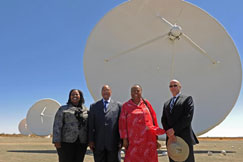Science and technology
Start getting excited about SKA: Zuma
'On the cutting edge of science'
Zuma said that few would have thought such a massive development could take place in an area as remote as Carnarvon. He said it was proof that as a country, "we have made it". SKA project director Dr Bernie Fanaroff told SAnews that with the completion of the SKA telescope, South Africa would be rated among the best in the field of science and technology, adding that the project would attract lots of foreign investment into the country. Fanaroff described the SKA project as the world's biggest scientific instrument. "The project is going to reveal new things globally, and our young people will no longer have to travel to overseas to study science."MeerKAT project taking shape
The MeerKAT telescope is currently taking shape in South Africa's Karoo region, with close to 100 young scientists and engineers working on the project. It will be the largest and most sensitive radio telescope in the southern hemisphere until the SKA is completed around 2024. Currently, seven fully operational dishes have been built in Carnarvon. By 2016, there will be about 64 dishes completed and operational and by 2024, it is expected that there will be about 2 000 dishes. Asked about the benefits of the project for the local community, Fanaroff said many residents had been employed to the project, and local businesses were receiving a boost by the many visitors to the area. Many tourists who wanted to visit the SKA were also supporting local accommodation establishments. Seventeen-year-old Jason Slaverse, a Grade 12 student at Carnarvon High, told SAnews on Tuesday that the SKA project had sparked his desire to pursue computer science as a career, although he has had a passion for science since he was young. Source: SANews.gov.za
Northen Cape Acting Premier Criselda Jikela, President Jacob Zuma, Home Affairs Minister Naledi Pandor and Science and Technology Minister Derek Hanekom at the Square Kilometer Array (SKA) site in Carnarvon, Northern Cape, 9 October 2012 (Photo: GCIS)




